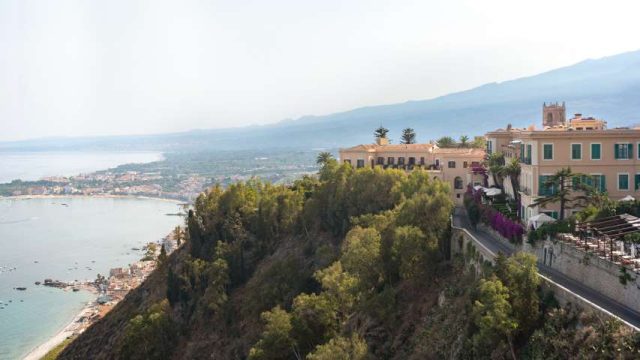Despite the Iberian Peninsula reaching further west than any other part of Europe, Spain’s relationship to Eastern thought and culture through its connections to North Africa have peppered it with distinct non-Western flavors. Additional royalist, Roman Catholic and revolutionary traditions have folded its past into a history unparalleled in Europe.
These characteristics made it an irresistible destination for artists with an appetite for exotic, diverse, and still reachable touchstones for modern art. The American take on this fascinating story of migration and inspiration is on gorgeous display at the Milwaukee Art Museum, in a broad and comprehensive exhibition, “Americans in Spain: Painting and Travel 1820–1920,” through October 3.
Co-organized by the Chrysler Museum of Art and the Milwaukee Art Museum, the exhibit features over 100 individual works–paintings, photographs and prints–drawn from institutions as renowned as the Prado and the Musée d’Orsay, as well as dozens of other lenders from around the world. There’s even a recently discovered portrait by Mary Cassatt from a private collection in Spain. Co-curators Brandon Ruud and Corey Piper avoid an airtight categorical articulation of this sprawling subject, choosing to break up the story into a number of sub-sections that highlight its most compelling and colorful individual chapters.
Peek Behind the Curtain
The exhibition begins with a peek behind the curtain of the royal court in Madrid and copies of famous works by masters such as Édouard Manet, James McNeill Whistler and Robert Henri from the Prado museum. Established after the Napoleonic wars to showcase Spain’s cultural treasures, the Prado quickly became an artistic pilgrimage spot for Americans, offering the best examples of Spanish masters to be copied.
![]() Stay on top of the news of the day
Stay on top of the news of the day
Subscribe to our free, daily e-newsletter to get Milwaukee’s latest local news, restaurants, music, arts and entertainment and events delivered right to your inbox every weekday, plus a bonus Week in Review email on Saturdays.
The official copy register of the Prado as a result is a who’s-who of the modern canon. One of the copies on display is a full-scale replica of Diego Velasquez’s Queen Consort Mariana by Henri. Its loose treatment predicts the American Ashcan painter’s later loose brushwork and validates the value of what might seem a less-than-creative endeavor. An adjacent portrait of Mariana by Juan Bautista Martinez del Mazo mirrors Henri’s skills of replication, and the tandem works finally illustrate the famously inbred Hapsburg facial deformities, most pronounced in the Consort’s son, Charles. It’s said to have left him unable to eat or speak properly.
The visual tour at MAM eventually departs the Royal Court in Madrid and glides casually into sunlit Mediterranean gardens and Muslim-inspired architecture of Andalusia, including the Alhambra Palace in Grenada and the Great Mosque in Cordoba. If the royal courts in Madrid endowed Spain with its canonical body, its Jewish, Roma and Islamic traditions provided it with its mystery, eccentricity and romantic spirit. The show includes several paintings and lithographs of the Alhambra, where many of those spirits still lurk. The show also provides dozens of more intimate views into sun-dappled Byzantine courtyards and verdant patios by artists such as Robert Frederick Blum and Joaquín Sorolla. These outdoor scenes build on each other. Each luminous brush stroke from the muzzle of a donkey in John Singer Sargent’s Moorish Courtyard, and sun-raked step in Child Hassam Church Procession, immerses us further into the glorious and enveloping atmosphere of southern Spain.
Sunny Spain
By the time we encounter William Merritt Chase’s Sunny Spain we can almost feel the sun baking the backs of our necks. The composition depicts two women carrying water jugs through the thirsty, putty-colored outskirts of mid-19th century Madrid. We see smokestacks in the distance, suggesting the industrial transformation on the horizon. Like Monet’s many sketches of Argenteuil, we watch modern and rural traditions square off. Still, Spain remained more rural and agrarian than France or the States, and as a result offered unique views into the lives of its working class.
Galleries dedicated to “Spanish People, Spanish Characters” and “Spanish Labor and American Art,” take us deeper into those lives. A fascinating painting by Mary Cassatt, After the Bullfight, squeezes labor and performance into a single portrait, featuring a dashing Spanish toreador coolly lighting a triumphal cigarette. Where Cassatt’s painting revels in the color and eccentricity of Spain’s romantic traditions, Walter Gay’s Cigarette Girls, Seville tiptoes the line between past and future. It does this by providing a POV look into an expansive workshop where traditionally dressed women hand-roll cigarettes. Such workshops live somewhere between the cottage industries of pre-industrial Europe and the specialized mega-factories poised to redefine modern labor. Even with its focus on prosaic laboring, its focal point of a dazzling red rose pinned to the hair of a woman in the foreground evokes the heroine of Bizet’s 1875 opera, “Carmen,” which endures as perhaps the single most seductive symbol of color, costume and movement in the 19thth century Spanish repertoire.
|
|
The Allure of Carmen
Set in 1830, first performed in 1875 and popularized after early resistance by the late 1800’s, Carmen centers on the exotic effervescence of the working-class Gypsy protagonist and her tragic love affair with a Spanish soldier. The allure of her image inspired John Singer Sargent’s El Jaleo, and The Spanish Dancer, a brilliant study of which is included in the exhibition. Also indebted to Carmen, if indirectly, are portraits of the Spanish performer Carmencita, by Sargent and William Merritt Chase, each offering lively action shots of the famed dancer in full costume after a set of performances in New York City in 1890. Each work embodies the height of academic painting traditions offered in a distinctly Spanish manner, pairing bursts of warm color against dark sooty backgrounds.
As entrancing and informative as this artistic travelogue at MAM is, it begs some questions. A painting by William Merritt Chase, Antiquary Shop, urges one to consider the nature of its “Eastern-ness.” The scene depicts a man in a turban holding a sword in an outdoor market that we know from Chase’s own notes are based on sketches from Venice as well as Spain. Both sites were on the Grand Tour of Europe, readily available for the sufficiently endowed art student. Like many of Chase’s and others’ works, this exoticized scene is a hybrid of various moments and cultures, compiled finally in a studio far from any bazaar. To some unknowable degree, Chase’s vocabulary reflects a very real and creeping late 19th century Orientalism. How much is food for endless thought, and one of the joys and responsibilities of processing a show such as this.
The story at MAM finds leaves those questions behind as it flirts with the beginnings of high modernism, a movement that traded exotic content for exotic forms, abandoning the naturalism of Sargent, Henri, Chase, and other stars of this exhibition. “Americans in Spain” sends us off with a gallery of painters once marginalized by the academic world. The works of El Greco and Francisco de Zurbarán emerged as standards as their idiosyncratic, individualized treatment of subject matter proved to be fertile alternatives to the high academic tradition.
El Greco’s powdery, contrasty mannerism in particular reflects a turn toward expression and interiority. His portrait of Saint Catherine in the exhibition is a fine example of his eccentric style. As Velázquez did a generation before, El Greco would serve as an example to expressionists as diverse as Matisse, Malevich and Pollock in search of pre-modern examples for their modern aims.
Paris was the undisputed center of the art world during most of the period covered by this exhibition. Picasso was Spanish, born in Malaga in 1881, but he’s associated with Paris more than any other place. It’s telling that it’s “Paris,” though, and not “France.” France centralized over the course of the 19th century. And culturally Paris was The Center. And New York waited on deck. Meanwhile, Spain bathed silently for a century in the diffuse religious, ethnic, geographical, and cultural mysteries that’s always made it difficult to pin down. Over time it continued to be an enigmatic alternative to the orthodox art centers—more witchdoctor than doctor, more seductress than debutante.
One thinks of the line in the Jane’s Addiction song that “Jane says she’s going away to Spain, when she gets her money saved.” A hundred years since the birth of modern alternative culture, Perry Farrell would never have had Jane going to Paris or Hamburg, whether it rhymed or not. When seeking romantic consummation, one chooses Iberia over Central Europe instinctively. The reasons for this are impossibly complex, but “Americans in Spain: Painting and Travel 1820–1920” provides a fascinatingly thorough attempt to locate those reasons, revealing the time and subject in all its artistic paradoxes: old and new, near and far, East and West.








